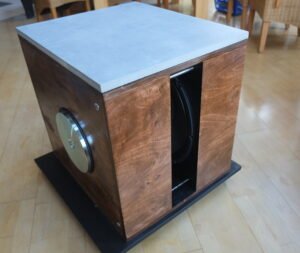Ralph, when you say no SET can make full power of 20 Hz, does it matter if you’re only getting 35 Hz in room and you only need 10% of the power of the SET to get you to the volume you need?
In other words, are you describing a condition that is not often met under normal use?
This is a good question. The room response and speaker bandwidth have no bearing on this issue. Even if the speaker lacks the response, the voice coil is still loading the amp (the amp is still doing work). That is why I said in my last post that a non-inductive resistor would yield the same result. But if you are using the 16 Ohm tap and the speaker is efficient enough, this problem
is reduced.
This amp will also do 20Hz-20Khz full power.
No, it won't. It will do that at a reduced level though. 'Full power' means 'just below clipping'. In this case, citation is required (photos or it didn't happen).
Because for realism 35 Hz is sufficient. It is more important to have sufficient, balanced bass, than deeper, boomy bass, depending on room, with as less a treatment as possible.
Sorry- if you want more 'realism' you
have to provide the foundation. There's a lot of information below 35Hz.
If the ear senses a lack of bandwidth, its internal tone control will tilt the tonality. A lack of bass emphasizes the highs, too much bass and the highs get muddy. The trick to getting the bass right (to avoid boomy bass) is to use a Distributed Bass Array (DBA) so standing waves (which can cause boomy bass) are eliminated; no room treatment needed. You need multiple subs for that, asymmetrically placed about the room, unless your main speakers do the bottom octave, in which case you might only need two.
Agree. 35Hz of 'proper' bass is really good. ~35Hz is the lowest C# on a piano with only 4 notes below that. An organ, piano, harp (barely) and contrabass sarrusophone (barely) can get that low but no other acoustic instruments go that far. A double bass and a bass tuba can get to around 41Hz.
Bass drums
are acoustic and go below 35Hz.Big bass drum whacks are kinda what made some of the early Living Stereo LPs worth so much money before they were reissued in the 1990s. Pipe organs are acoustic and can go to 16Hz (St. Saens Organ Symphony is a good example of this in action, also heard on The Planets by Holst). If a string bass has the low C option added to it, which is not that rare to see, its lowest note is 27.5Hz (I play bass FWIW...). And of course electronic music can go that low. Certain EMI recordings done in Kingsway Hall have subway rumble recorded in them due to the Piccadilly Line.
There are all kinds of signals below 35Hz. There can be subsonic signals in the recording such as those of Kingway Hall or it can be caused by playback (record warp). If you don't filter these things out of an SET you're missing a bet!
Most natural instruments don't go lower than around 40Hz. Only a couple of keys on a piano and pipe organ really. Still it also depends on how many dB down they are at 35Hz.
So it sounds like a different definition of 'HiFi' is being proposed. Obviously this is a rationalization and should be treated as such, which is to say its rubbish.
It’s better to have just 30hz - 35 Hz of the kind of more believable and authentic sounding bass that a really well implemented SET can do than 20 hz of a one note doof roof artificial kind of sounding bass that lesser amplification tends to deliver.
I find that a good SET within the context of acoustic instrument performance can display overall a more lifelike quality of bass over the more synthetic hifi’ish hyper-real bass that some amplification types typically render… everyone’s mileage on bass varies… I go cohesive lifelike quality over just an overt soul less disconnected quantity of bass when it comes to great music anytime.
Its possible to have realistic non-one-note-bass if you use a DBA to break up standing waves in the room. To this end, you can use a mono bass signal, since bass below about 80Hz in most rooms (unless enormous) is 100% reverberant. This means if you keep the subs running below that frequency you don't have to time align them and as long as they don't play above that frequency they won't attract attention to themselves.
And having heard them and liked them, there is also the Yamamura, Pnoe (single driver systems), altec 817, which are equally good and on some fronts better, and Leif's horn which is with woofers. There is no reason to have pursue subs - if the midbass horn rolls off at 75 - 80 hz, sure, if it goes to 35 or 40, not required.
The reason is stated above: standing waves. They can cause boominess or a bass suckout. My main speakers are flat to 20Hz and are 98dB and 16 Ohms. Without a pair of subs to break up standing waves, there's no bass at the listening position, even though three feet away there is. My room is nearly square. The DBA works a treat.



















